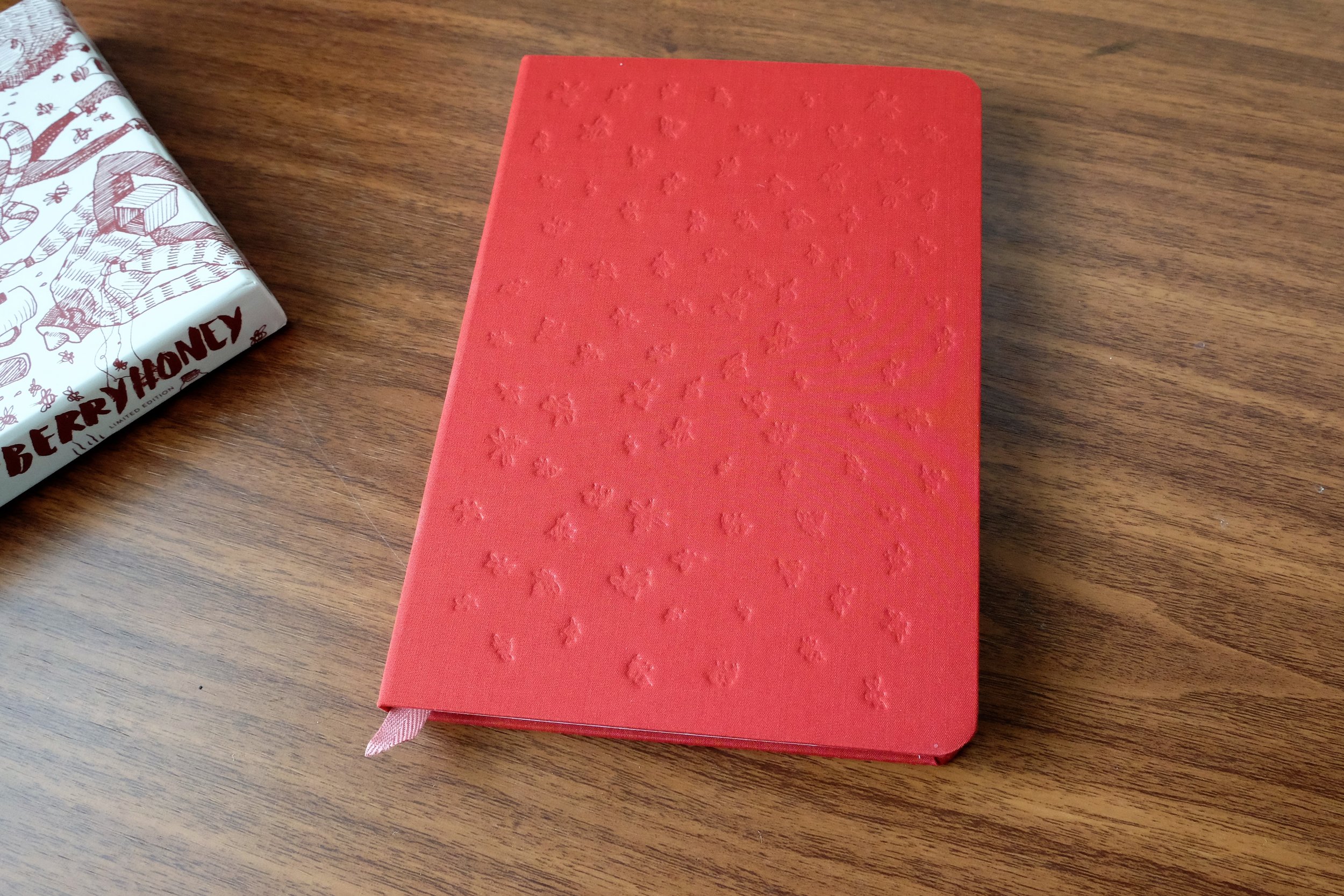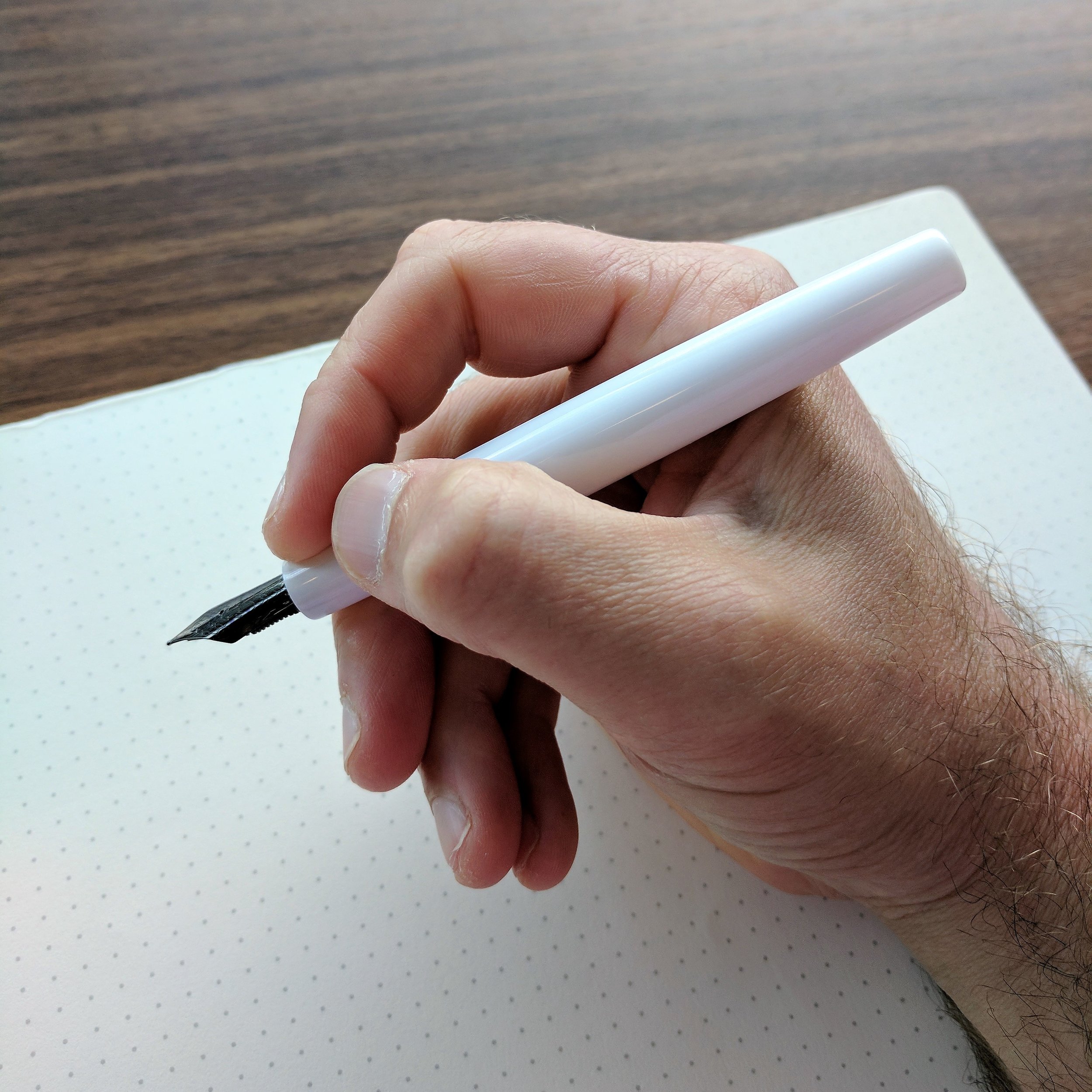Until recently, Platinum was known for having a well-regarded but extremely limited lineup of inks. The company had a standard black and blue-black, as well as a small line of pigmented inks. Then came the "mix-free" inks, which are high-quality, but a lot of people write them off (ha!) because there's a perception that you need to purchase the entire set in order to enjoy them, as the purpose behind the inks is to be able to mix them to create any color you like. This year, Platinum expanded their ink lineup yet again, releasing six new "Classic" inks in somewhat offbeat colors: "Cassis Black," "Forest Black," "Citrus Black," "Sepia Black," "Lavender Black," and "Khaki Black."
You may wonder, what's with the "black" theme? Well, all of these inks are iron gall inks, meaning that Platinum has added iron to the ink in order to make it permanent and to give it color-changing (i.e., darkening) properties.
You can get a sense of the color change here: compare the cherry-red wet ink on the inside of the cap to the dried writing sample/swab (on Col-o-Ring Paper).
I picked up this bottle of Platinum Cassis Black at the Atlanta Pen Show back in April. While this particular color probably wouldn't have been my first choice, I really wanted to review one of the Platinum Classic Inks, and they were extremely difficult to find after they were first released. So what do I think? Here are my impressions:
- As it turns out, this is a great color. I love red inks, and this one is extremely interesting. It starts out as a bright cherry red, but it surprised me by drying to a deep burgundy with black undertones. Reds - and especially burgundies - are some of my favorite colors to write with.
- Like most iron gall inks, Platinum Classic ink feels a little dry for my taste. I'm not talking about bad flow - the ink flows well and pens will put a lot of it on the page - Iron gall inks are generally less lubricating and many people notice more feedback from the nib on the page.
- No feathering, show through, or bleeding at all on cheaper paper, even work-issue copy paper that can barely handle gel pens.
- These inks are a decent value. Though not inexpensive at $25 per bottle, you do get 60ml of ink.
Another writing sample in my Hobonichi Planner.
My Thoughts on Iron Gall Ink in General
Inks with iron content are commonly known as "iron gall ink," because they traditionally were manufactured using oak galls. This is ancient technology that goes back hundreds, if not thousands, of years. If you're looking to replicate that blue-black or sepia-black ink color that you often see on old letters from the 1700s or 1800s, you should pick up a bottle of iron gall ink. But other than aesthetics, why do people still use iron gall ink today?
- The inks dry extremely quickly.
- The inks change colors as they dry, leaving a very dark line in most cases.
- Iron gall inks are excellent on thin or cheap paper, and they don't feather. Many calligraphers love these inks because they allow you to write a very fine line.
- Iron gall inks are permanent and waterproof. [Edit: It's been brought to my attention that "water-resistant" is probably a more accurate term. See comments below.]
But won't iron gall inks corrode / eat your pens? You may have read "warnings" in various blogs and online forums that iron gall inks are dangerous and not suitable for fountain pens. In my opinion, categorical statements like these are off-base, because you can absolutely use iron gall inks in most fountain pens as long as you take certain precautions. A few tips:
- If you load a pen with iron gall ink, use that pen, especially if it has a steel nib or metal parts, like a piston or vacuum-fill rod. When you hear reports of iron gall inks ruining pens, it typically involves the ink reacting with a steel nib or steel components that come into contact with the ink, and the pen being left to sit for a long period of time unused. You don't need to worry about gold or titanium, but a good rule of thumb that I follow is to use the ink or flush it after a week, regardless of what pen it's in.
- Under no circumstances do you mix iron gall inks with non-iron gall inks. If you're emptying a pen that was loaded with an iron gall ink, CLEAN IT WELL. Otherwise, the different inks can react and create clogs.
- Vanness Pens has an excellent discussion of iron gall inks and precautions you should take on their KWZ Iron Gall page. (More on the KWZ inks below)
A Montegrappa Fortuna nib that was damaged by old formulation Montblanc Midnight Blue. Note that the black coating on the nib was corroded along the nib slit and at the base. The nib still writes perfectly fine, but this was my fault for leaving the ink in the pen for too long. (Approximately two weeks).
Takeaways and Where to Buy
I don't use iron gall inks on a regular basis, but it's not because I have any great fear of damaging my pens. I just generally prefer more lubricated inks. I do, however, keep a couple bottles around in case I need a permanent ink or an ink that works well on super-cheap paper. Standard Platinum blue-black is my personal favorite.
If you're interesting in testing out iron gall inks, Vanness Pens has one of, if not THE, largest selection of modern iron gall inks available. In addition to the Platinum Classic Inks mentioned above (and you can purchase a sample set of all six), Vanness also carries the entire line of iron gall inks by KWZ, which manufactures an extensive range of colors. If you're looking for a traditional blue-black, another option is Diamine's Registrar's ink. Finally, Rohrer & Klingner makes the Salix (blue-black) and Scabiosa (purple-black) iron gall inks that many people love. Montblanc Midnight Blue was reformulated a few years ago to remove and/or significantly reduce the iron gall content because there were reports of it corroding pens (which I experienced personally - check out the picture above).
I'm sure there are other options, and if you are looking for a specific color ink with iron gall properties, reach out to the folks at Vanness Pens. They'll be able to point you in the right direction.
Disclaimer: Vanness Pens provided me with the bottle of ink featured here for review purposes. I was not otherwise compensated for this review.







